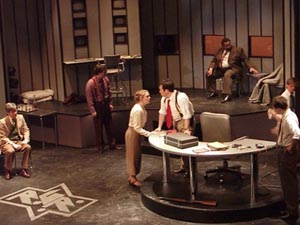
An adaptation of Czechoslovakian playwright Karel ?apek’s 1920 play “R.U.R.” by University of Alabama at Birmingham (UAB) Assistant Professor of Theatre Lee Shackleford, M.F.A., will open Jan. 9, 2013, at the Beckett Theatre on New York City’s Theatre Row.
Theatre UAB premiered Shackleford’s adaptation in 2002, but the play, which has been translated into most major languages, has been considered a classic for more than 100 years. “R.U.R.,” which stands for “Rossum’s Universal Robots,” gave the world the word “robot” — the Czech word “robota” meaning drudgery or forced labor. The plot of “R.U.R” focuses on an island factory that makes artificial beings to be used for human service. The “robots,” which are at first content with their domestic servitude, start a hostile rebellion that threatens the existence of humans.
The show will be produced by the Resonance Ensemble and directed by Valentina Fratti. It will be performed in repertory with Richard Manley’s Gassner Prize-winning robot play “The Truth Quotient.” The plays will run through Feb. 2. “R.U.R.” will open almost 23 years to the day after Shackleford’s play “Holmes and Watson” opened in New York.
“Naturally I am very excited about having another show in New York City,” Shackleford said. “I’ll be happy to have another NYC show 23 years from now.” Shackleford was on hand in New York in late November for the play’s readings. Award-winning Theatre UAB 2010 alumnus Dustin Cañez is the show’s assistant director.
Modern productions of “R.U.R.” have become few and far between, Shackleford said, because directors and producers do not like the expressionist style of the script, or the exaggerated action. The awkwardly formal language of the most literal English translations leaves much to be desired as well.
“So in my adaptation of ?apek’s masterpiece, I have tried to bring the play’s characters and language into a more modern vernacular than in the literal translations,” Shackleford said. “I’ve tried to be as faithful as possible to his intentions while updating the details of the ethical issues raised and, above all, approach the story as a more realistic piece of science fiction with more fully-rounded characters.”
